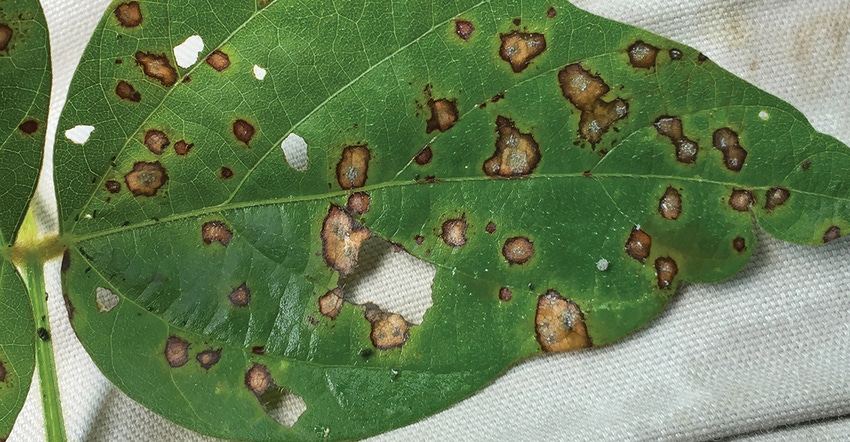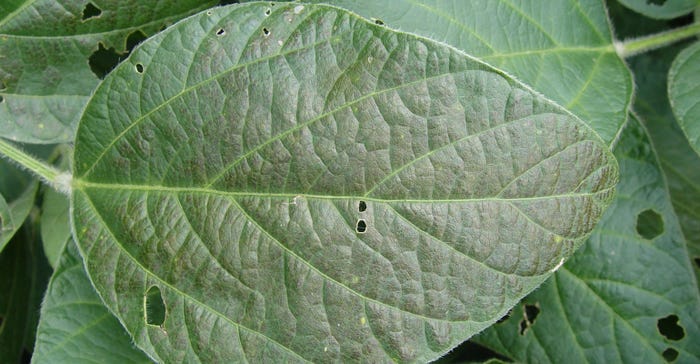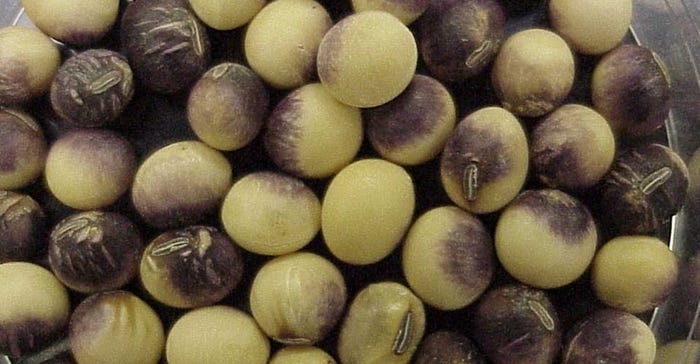
Heavy spring rains delayed planting in Missouri and created the ideal environment for foliar diseases like frogeye leaf spot to flourish. Syngenta agronomist Brett Craigmyle says farmers should protect their soybean crop by applying a fungicide early in the growing season.
"This year, plan to make a fungicide application at the R3 stage," he says. He says the disease risk is high if the weather remains hot and humid. With later-planted soybeans hitting early growth stages during warmer months this year, he says farmers need to remain diligent in scouting for foliar disease.
There are two main foliar diseases to watch for this year. They include:
1, Frogeye leaf spot. There were reports of this disease in Missouri fields last year, says Syngenta agronomist Scott Gard. He notes that scouting should be done at the beginning of the R1 growth stage, when plants start to bloom, as younger leaves are more susceptible. The disease presents with small, circular lesions on the upper leaf. These lesions look dark at first, but older lesions have a light center with dark outer ring. Farmers may notice frogeye leaf spot when walking through and finding holes in the leaves. Craigmyle says that left untreated, this disease can cause 30% defoliation. The disease reduces yield.
2. Purple seed stain. This starts out as Cercospora blight on soybean leaves. Symptoms appear later in the R5 stage, when plants are starting to set seed. This disease often starts under dry conditions at pod fill, and then wet weather follows. The upper leaves turn reddish-purple in color. The purple seed stain occurs when the fungus infects the seed. The seed coat turns purple and reduces seed quality.

STARTING SIGN: Cercospora blight is another foliar disease in soybeans that thrives in hot, humid conditions. It starts as a purple color in the leaves but can move into the pods.(Photo courtesy of University of Nebraska)

Disease treatment for frogeye
When it comes to frogeye leaf spot Craigmyle says that fungicide resistance complicates the situation. "In the Bootheel area of Missouri and the Deep South, they are dealing with strobilurin fungicide resistance," he notes. Syngenta offers Quadris Top SBX. Farmers can also apply Trivapro.
Craigmyle recommends growers applying Trivapro to soybeans at the R3 stage. This timing, he says, is when the fungicide is "most effective to protect against disease and other environmental stress factors."
Trivapro contains three active ingredients for both preventive and curative disease control. Trivapro also offers three modes of action to protect the soybeans from new pathogen growth, movement and yield loss through harvest.

CHECK YOUR PODS: Purple seed stain is a result of the foliar disease Cercospora blight. It manifests as purple-colored soybeans, like the ones shown here. (Photo courtesy of University of Nebraska)

Too late for purple seed stain
Cercospora is a disease farmers need to anticipate early. Application of foliar fungicides during early pod stages may help prevent foliar blight and pod infections.
Unfortunately, once purple seed stain sets in, there is little a farmer can do to bring the bean back from the fungal infection. However, Gard says that farmers should make a note of the problem and prepare for 2018.
He says crop rotation can help reduce Cercospora in the future. Tillage can also reduce soybean residue, which is where the pathogens survive.
"Make notes all season long on issues in each field," Gard says. "It can help in making decisions this fall for next spring."
About the Author(s)
You May Also Like






